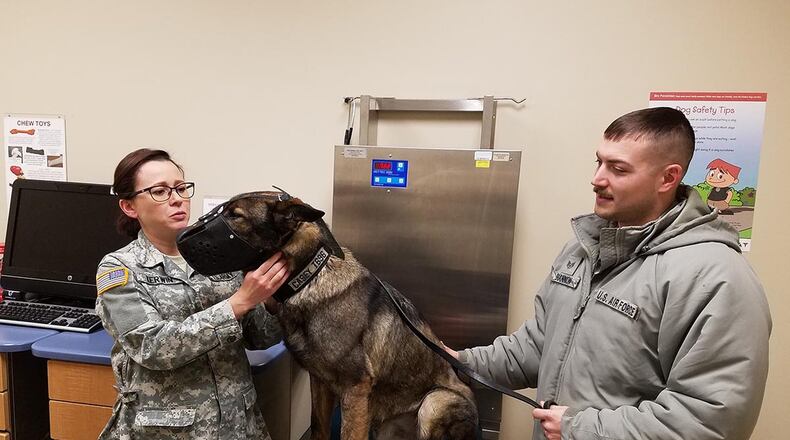The veterinarians are also responsible for public health, on deployments and stateside, ensuring all food consumed by military members and military working dogs, was purchased from a reputable vendor and stored and cooked correctly for consumption.
“At the moment, we are seeing about 10 to 15 pets daily,” said Army Capt. Cassandra Kerwin, veterinary doctor/branch chief and officer in charge of the veterinary clinic, 88th Medical Group. “Our other veterinarian, Dr. Jessica Clarkson, just recently returned from a deployment, and we’ll soon be back to seeing about 30 pets daily.”
“I manage the clinic, and I see appointments as well,” said Kerwin. “But the main mission is the military working dog.”
The veterinary clinic provides the basic services for military working dogs and service member’s pets. Those services include yearly vaccinations, deworming, nail trimming and routine lab work.
Clarkson was able to provide some written input responses to the types of animals seen at the base vet clinic.
“Dogs and cats are 99.9 percent of the types of animals we see,” she said. “We might see a pet rabbit or rat for nail trimmings or health certificates for PCSing clients.”
They refer some patients off base if they require surgeries, allergy testing and management, hospitalization for illnesses that require 24-hour care and after-hour emergencies.
Kerwin recently had an appointment with canine patient, Sadie Peck. Sadie is a 5-month-old, completely black, purebred American Kennel Club-registered German Shepherd.
She was with her human mom, Jessica Peck, and her human sister, 6-month-old Alexis. Peck’s husband is 2nd Lt. Nathaniel Peck, project engineer, Air Force Research Laboratory Aerospace Systems Directorate, Electrical Systems Branch.
Kerwin began the physical by getting down on the puppy’s level with a small doggie treat in her hand, and she told Sadie to “sit.” The pup did as she was commanded, and while Kerwin was feeding him little treats, she was also checking his teeth for any obvious signs of decay or other oral issues.
All the while Kerwin is examining Sadie, she is asking Peck different questions about the dog’s health and habits. Then Peck is asked to lift the pup up on the exam table where her weight, eyes, ears, nose and lymph nodes are checked.
Lastly, Sadie was given her shots and vaccines, and Peck was given information about heartworm vaccines before she checked out.
“At a minimum, they [the working dogs] need to be seen twice a year for check-ups,” she said. “But also as needed for sick call.”
Kerwin’s next patient was 6-year-old, Casey, a military working dog who recently had surgery for a ruptured disk. Casey’s handler is Staff Sgt. Curtis Shannon with the 88th Security Forces Squadron.
“Canine handlers have a 3-month training with the dogs at Lackland Air Force Base, Texas,” said Shannon. “Once we get to our permanent base, we are assigned a dog, and the working dogs do not leave their bases when a handler has a permanent change of station.”
The exam table was lowered so Casey could get on it. He was weighed and examined. Kerwin questioned Shannon about how the dog’s post-surgery physical therapy was going, and he explained that the dog was having some difficulty with the therapy ball.
“He tends to always lean toward the right side,” said Shannon. “Whenever we shift his weight toward the right side, he expresses a little bit of pain.”
Kerwin suggested they lessen the time on the therapy ball by a couple of minutes to see if that helps the dog’s anxiety of the pain he’s expressing with that part of the exercises.
Shannon was advised to follow-up with the clinic as Casey continues to heal from surgery.
To schedule an appointment at the veterinary center, call 937-257-6853.
About the Author
